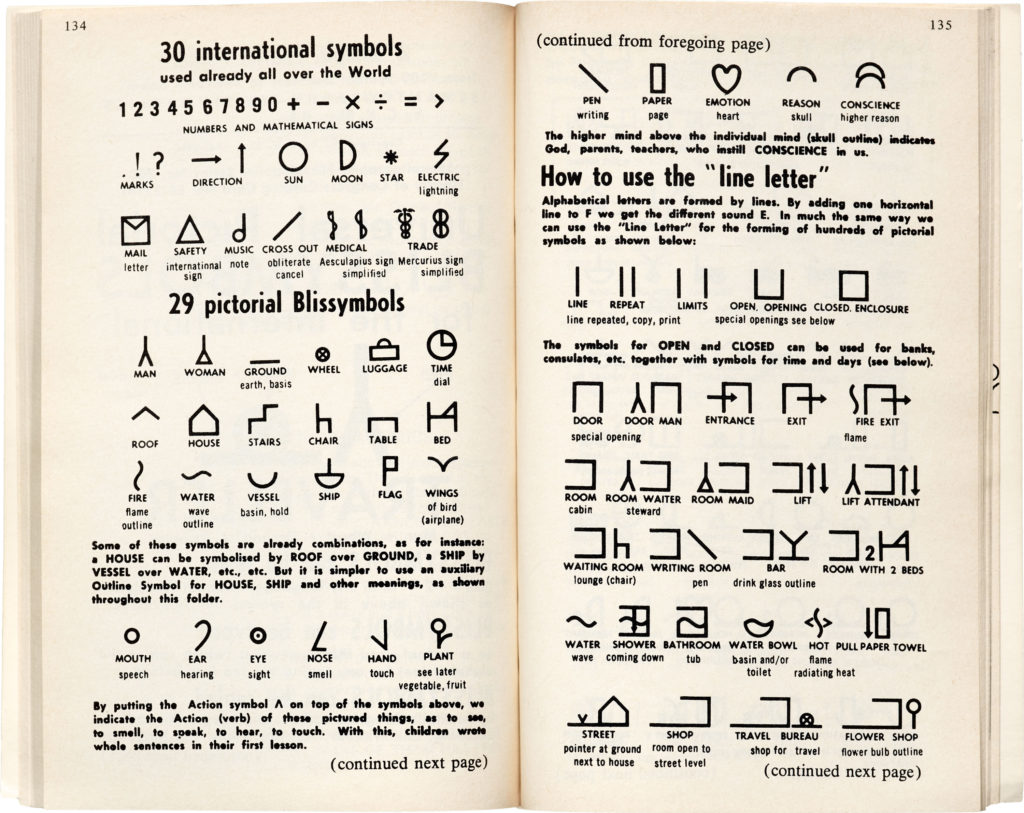…
Blissymbolics was conceived by Austro-Hungarian expatriate Charles K. Bliss (1897–1985), born Karl Kasiel Blitz to a Jewish family in the town of Czernowitz (now Chernivtsi in modern-day Ukraine). He was introduced to signs and symbols at an early age in the form of circuit diagrams – his father’s many occupations included mechanic and electrician – which he understood immediately as a “logical language”. Bliss (then Blitz) attended the Vienna University of Technology for chemical engineering and went on to become chief of the patent department at the German TV and radio company Telefunken, a career that was cut short in early 1938 when the Third Reich annexed Austria.
Bliss was sent to Dachau concentration camp, and then to Buchenwald, before escaping to England in 1939. The eight-month German bombing offensive against Britain known as The Blitz began only months later, prompting him to change his surname “from the war-like Blitz to the peaceful Bliss”, as he recalled in a taped interview. Bliss fled to Shanghai by way of Canada and Japan, where he was reunited with his wife. Claire, a German Catholic, had used her connections to get Bliss out of Buchenwald, but her relatively privileged status was not enough to spare her a fraught journey to safety across Europe and Asia. Even in Shanghai, the couple was forced into the Hongkew ghetto following the Japanese occupation.
Bliss became enraptured with written Chinese, which he mistook initially for ideograms. (Chinese characters are, in fact, logograms.) Nevertheless, certain Chinese characters have pictographic qualities, and it was the symbol for “man”, that sparked Bliss’s epiphany. As he learned enough to read Chinese newspaper headlines and shop signage, he soon realized that he was reading the symbols not in Chinese, but in his native German. At the age of 45, Bliss was inspired to develop a non-alphabetic writing system that could be mastered in a short period of time and read by anyone regardless of their spoken language. This work remained the focus of his life, even after he and Claire emigrated to Australia in 1946 and despite the general apathy and indifference with which it was met.
…
Fascinating article about the little-known “language” of Blissymbolics: coming from a similar era and background to Esperanto, Blissymbolics failed even more to gain widespread traction but encompasses some really interesting ideas (about graphic notation and design, about linguistic concepts, about communication theory) that we can still learn from. Read the full article…

Part of the failure to spread seems to be due to Bliss’s dogmatic resistance to allowing the system to adapt and be used for other purposes. His goal was to eliminate conflict by reducing misunderstandings, but he did this by insisting on rigid control of the language’s use. The protracted legal battle against the Ontario Crippled Children’s Centre was tragic and sadly ironic, as I do believe he had good intensions throughout. Maybe blissymbolics would have spread further as an open, organic system.
An excellent audio piece on Mr. Bliss is https://www.wnycstudios.org/story/257194-man-became-bliss
Fascinating insight, Spencer: thanks for sharing!